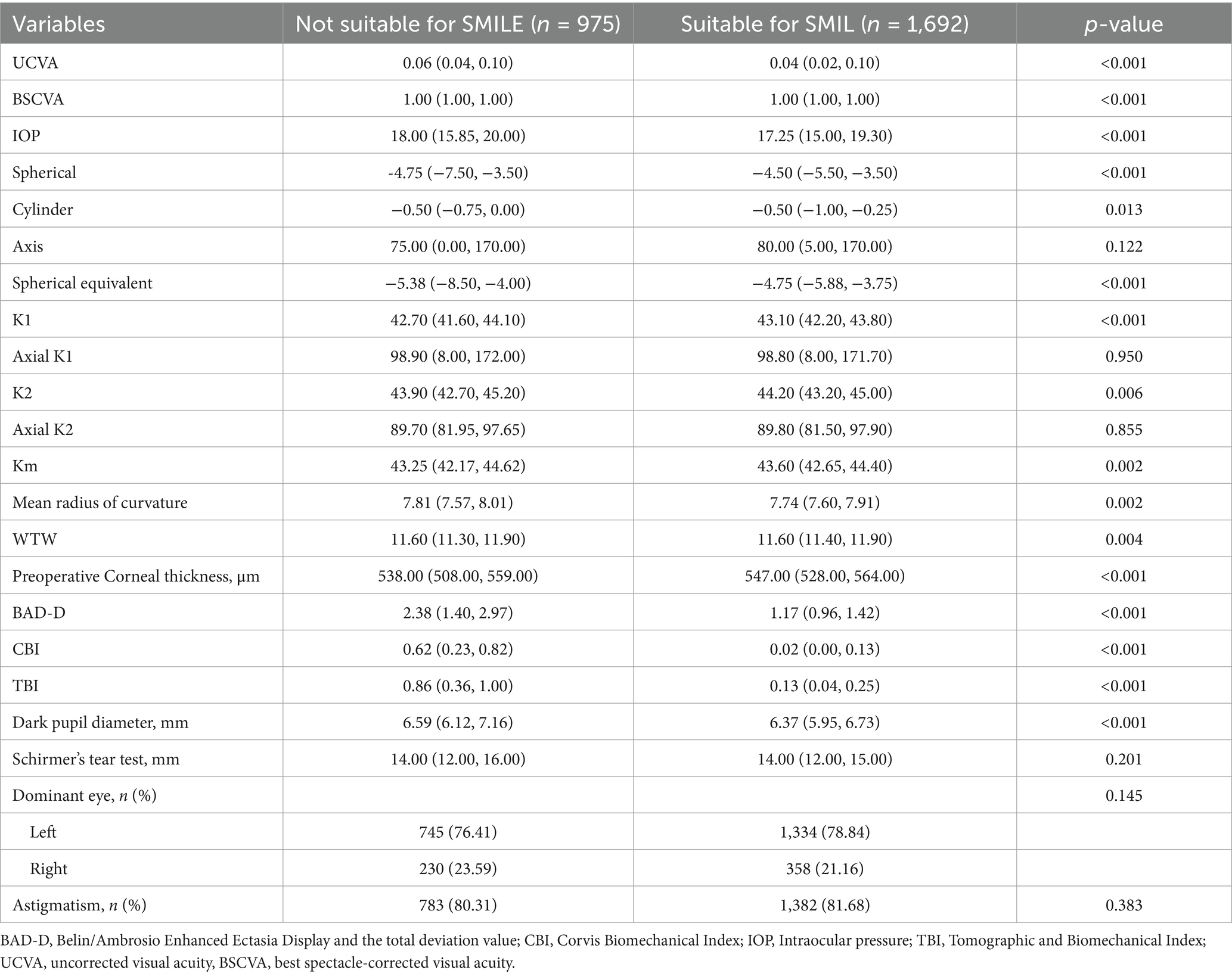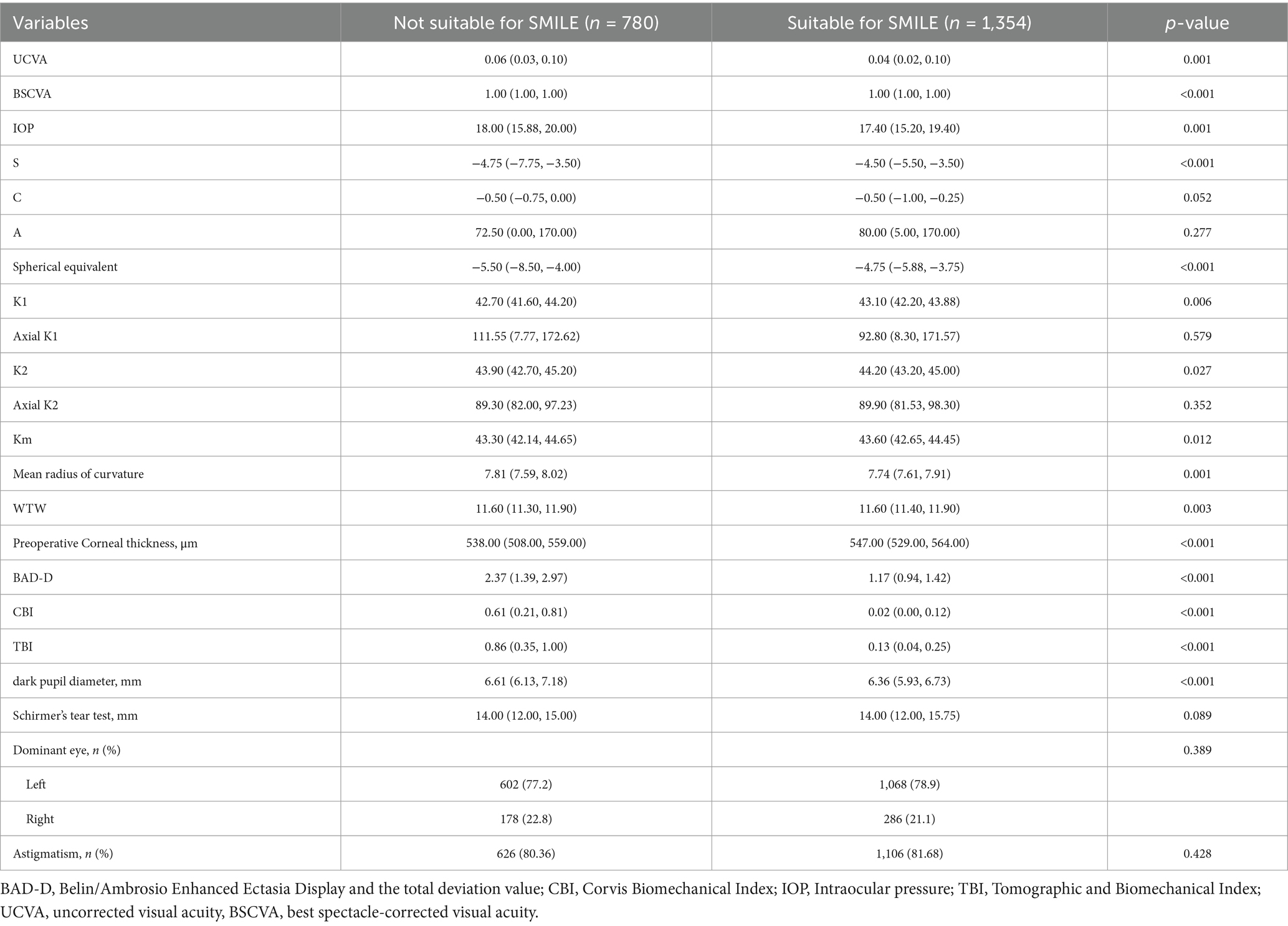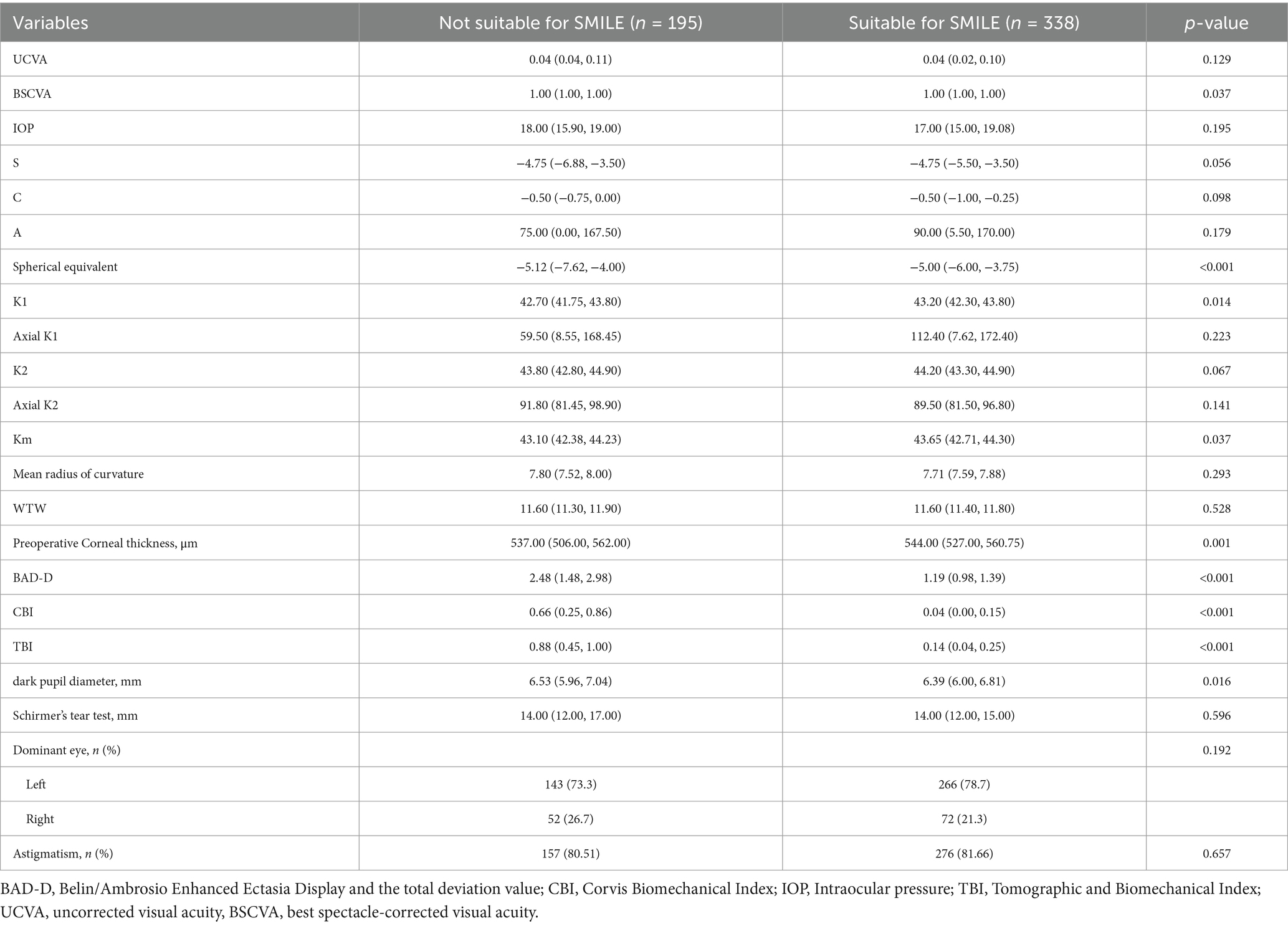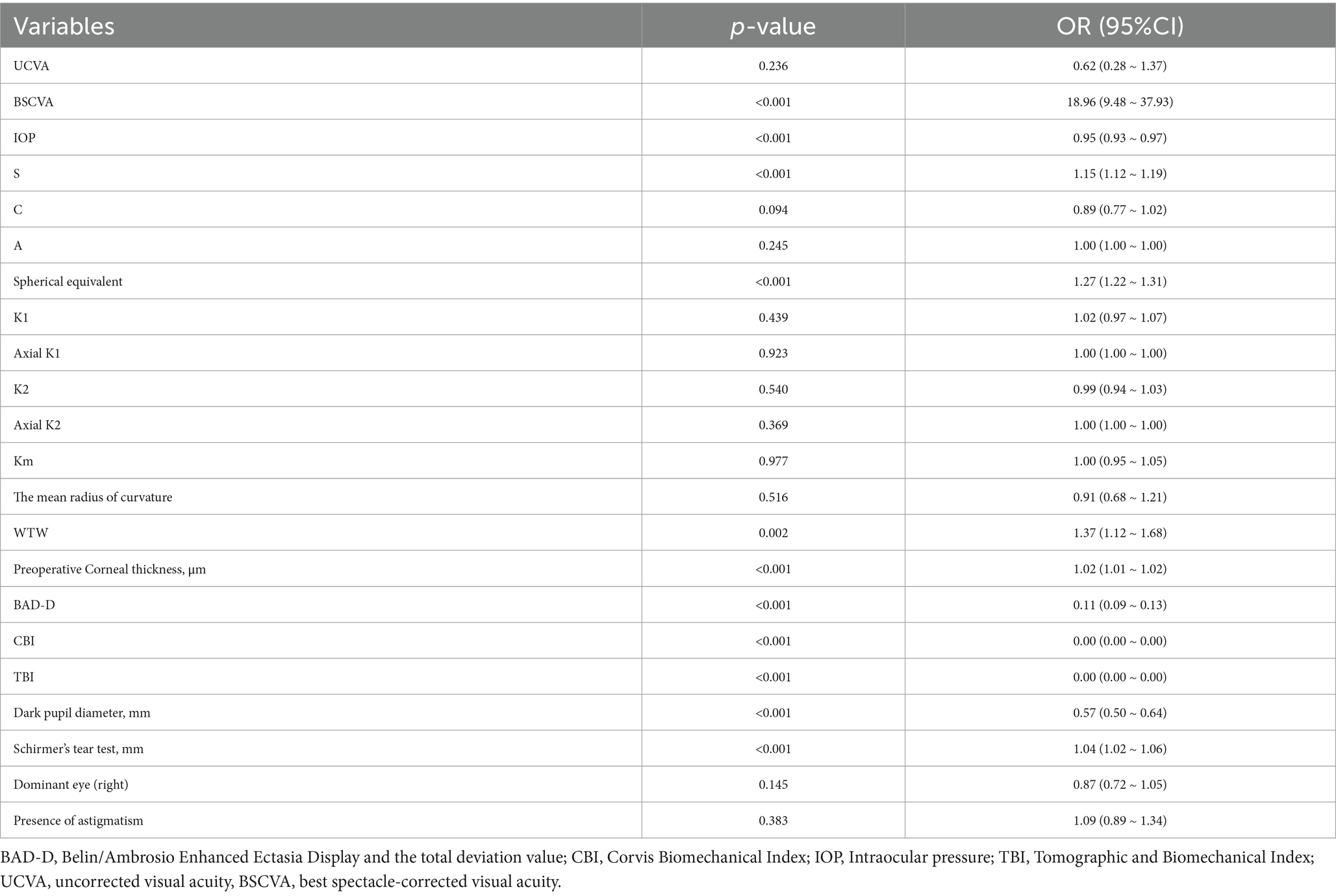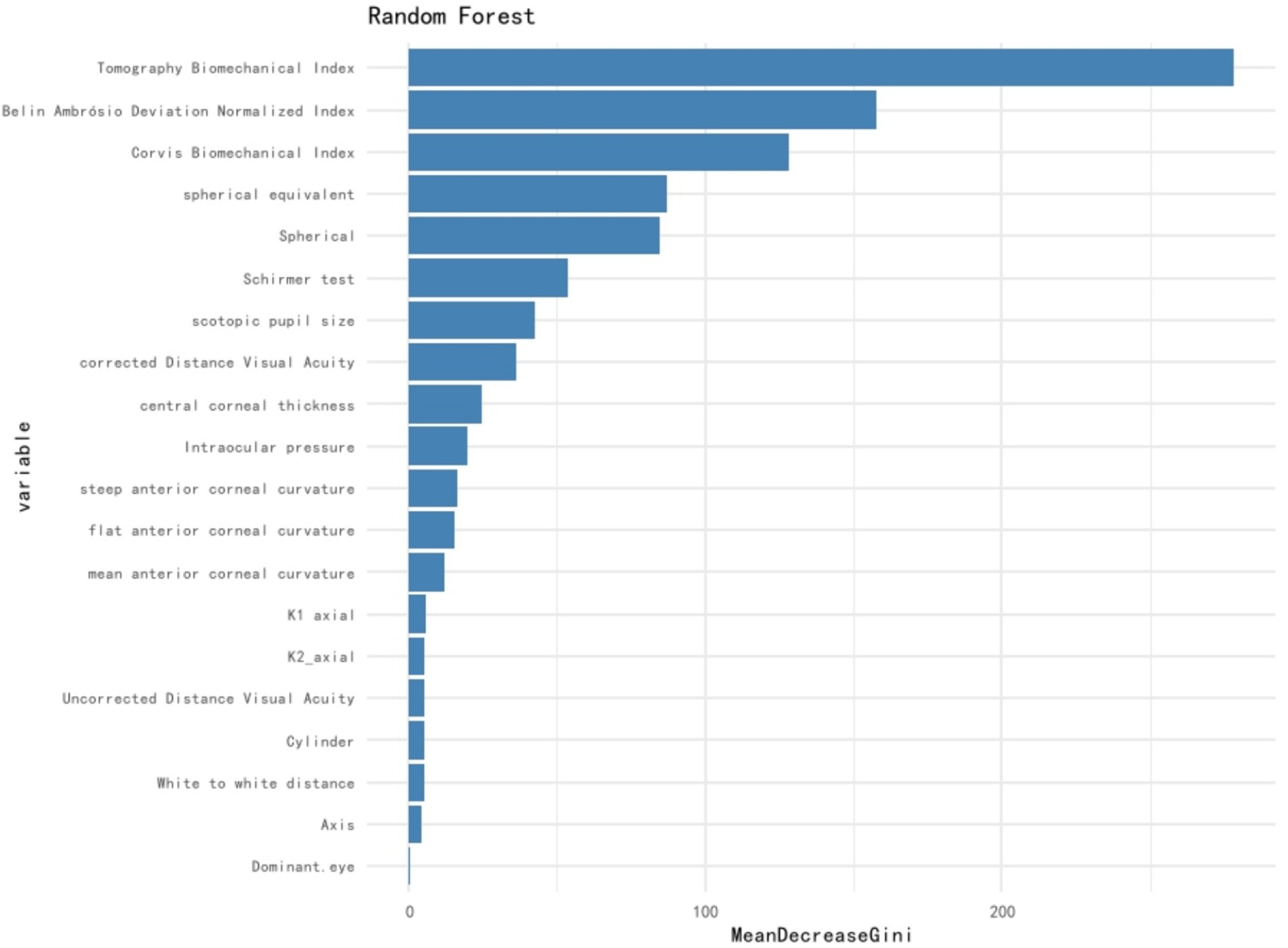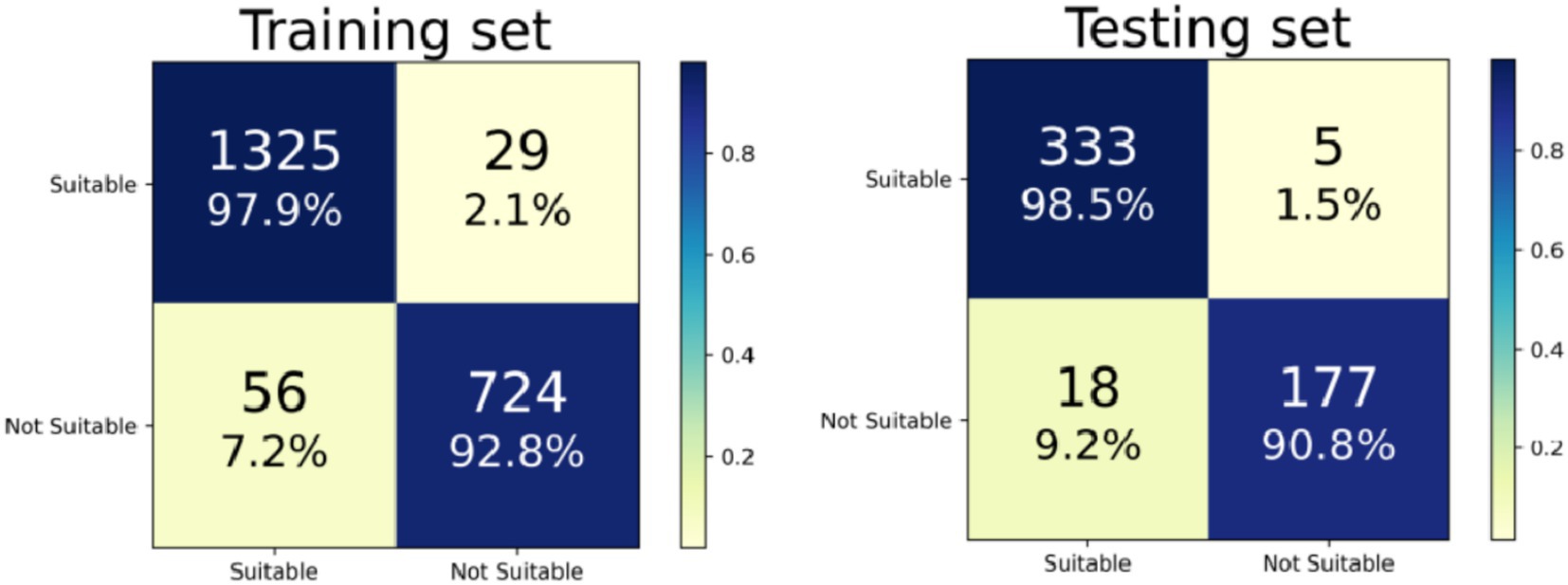- 1Renmin Hospital of Wuhan University, Wuhan, China
- 2Wuhan Bright Eye Hospital, Wuhan, China
- 3Tongji Hospital Affiliated to Huazhong University of Science and Technology, Wuhan, China
- 4Xiangyang Central Hospital, Affiliated Hospital to Hubei University of Arts and Science, Xiangyang, China
Purpose: This study aimed to identify risk factors associated with small-incision lenticule extraction (SMILE) surgery and develop a risk prediction model to aid in determining patient suitability for SMILE.
Methods: This retrospective study included myopia patients from four medical centers in China, enrolled between January 2021 and December 2023. The data were randomly divided into training and test cohorts at an 8:2 ratio. A random forest (RF) model was developed and optimized using three-fold cross-validation, with feature importance assessed.
Results: The study included a total of 2,667 patients, with 2,134 patients in the training cohort and 533 patients in the test cohort. Significant statistical differences were observed in the Belin/Ambrosio Enhanced Ectasia Display and the total deviation value (BAD-D), Corvis Biomechanical Index (CBI), Tomographic and Biomechanical Index (TBI), and spherical equivalent between patients suitable for SMILE and those not suitable, in both the training and test cohorts. The univariate analysis identified ten key features relevant to SMILE. The RF model developed from the training data demonstrated high performance, with an accuracy of 96.0% in the validation set and 95.7% in the test set, an F1 score of 0.967, and an area under the curve (AUC) of 0.976 (95% CI: 0.962–0.990).
Conclusion: SMILE is not appropriate for all patients with myopia. The RF model, based on clinical characteristics, showed excellent performance in predicting SMILE suitability and has potential as a valuable tool for clinical decision-making in the future.
Background
Myopia is a common refractive disorder in which the eye is too long or the refractive power of the eye’s optical system is too great (usually due to corneal protrusion resulting in excessive corneal curvature), causing images to focus in front of the retina, resulting in blurred vision at a distance (1). Epidemiological studies have shown that the global prevalence of myopia is increasing worldwide (2), and the estimated prevalence would reach 50% in 2050 if no effective intervention was performed (3). In the United States, the prevalence of myopia in people aged 12 to 54 years nearly doubled from 1971–1972 to 1999–2004 (25 to 42%) (4). The prevalence of myopia also varies by race and ethnicity. Chiang et al. (5) showed that the prevalence of myopia in other races, Hispanic, Mexican American, non-Hispanic Black, and non-Hispanic White were 42.77, 38.43, 34.23, 32.26, and 31.06%, respectively. And the worldwide prevalence of myopia is particularly high in Asians (6). Treatment of myopia depends on individuals’ symptoms and needs (7). The overall goals of treatment are to improve visual acuity, visual comfort (e.g., visual distortion, polymyalgia, decreased stereopsis), and other visual functions (e.g., color discrimination, motion detection, peripheral vision). First-line treatment includes corrective lenses, such as spectacles and contact lenses, or refractive surgery (8).
Small incision intrastromal lenticule extraction (SMILE) is one kind of refractive surgery performed using a femtosecond laser, and its early results were first reported in 2011 (9). SMILE became available in 2012, and the U.S. Food and Drug Administration (FDA) approved its use in the United States in September 2016. In a review of outcomes of SMILE patients, Song concluded that SMILE provided effective and predictable results and generally had equivalent outcomes with another refractive surgery option named laser-assisted stromal in situ keratomileusis (LASIK) (10). The long-term refractive regression was 0.48 diopters 5 years after surgery compared with 6 months after surgery, and there was no decrease in corrected distance visual acuity by two or more lines over the 5 years (11). Therefore, SMILE is now considered a safe and effective alternative to LASIK and photorefractive keratectomy (PRK) (12).
There are systemic and ocular contraindications to refractive surgery. Autoimmune diseases, collagen vascular diseases, and immunodeficiency disorders can impair corneal healing (13). Pregnant or lactating women can experience fluctuations in vision due to changes in corneal hydration causing refractive changes in the eye (14). Patients with scar tissue who have abnormal wound healing (e.g., keloids or abnormal scar formation) may experience abnormal corneal healing (15). Systemic medications such as oral isotretinoin can exacerbate dry eye symptoms, and amiodarone can leave transient corneal epithelial deposits (16). Although the U.S. FDA labeling contains a warning against laser refractive surgery in patients with diabetes, a literature review found that LASIK and PRK can be performed without complications in patients with well-controlled diabetes who do not have cataracts, diabetic retinopathy, or systemic complications of diabetes (17).
In summary, preoperative evaluation is crucial for decision-making in refractive surgery. This study focused on myopic patients seeking SMILE surgery to identify key factors influencing surgical suitability based on initial clinical examinations and medical history. By developing a machine learning model, we aimed to assist clinicians in determining the appropriateness of SMILE surgery for individual patients.
Methods
Study design and participants
This study included myopic patients who visited to Xiangyang Central Hospital, Affiliated Hospital to Hubei University of Arts and Science, Renmin Hospital of Wuhan University, Wuhan Bright eye hospital, and Tongji Hospital affiliated with Tongji Medical College of Huazhong University of Science and Technology from January 2021 to December 2023. The inclusion criteria were: (1) Myopic patients who intend to receive SMILE surgery; (2) Aged over 18 years or older; (3) Patients with relatively stable diopters, with recommended parameters: spherical equivalent within −0.75 to −10D, simple sphere from −0.5 to −10D, and astigmatism less than 5D. The exclusion criteria were: (1) Patients using systemic glucocorticoids or immunosuppressants, etc.; (2) Patients with diabetes, history of tumors, autoimmune diseases (including systemic lupus erythematosus, rheumatoid arthritis, multiple sclerosis, Hashimoto’s thyroid disease), scar constitution, mental illness; (3) Pregnant or lactating women. This study was approved by the Ethics Committee of Xiangyang Central Hospital, and informed consent was waived due to the retrospective nature of the study.
Data collection and definitions
Baseline data were obtained from the medical history system and included the following variables: age, gender, occupation, and history of local eye diseases. Ophthalmological examination data collected comprised uncorrected visual acuity (UCVA), best corrected distance visual acuity (BCDVA), astigmatism, intraocular pressure (IOP), spherical, cylinder, axis, funduscopy evaluation, corneal thickness and diameter, corneal ectasia or other corneal degeneration, dry eye evaluation, slit lamp examination, dark pupil diameter (refers to the pupil diameter of patients in dark rooms), corneal topography data, and the tendency of keratoconus.
Patients were categorized into two groups: those suitable for SMILE surgery and those not suitable. Experienced ophthalmologists made a comprehensive assessment based on ocular examinations, which included corneal topography and biomechanics, degree of myopia, and corneal thickness.
Model development and validation
The entire cohort was randomly divided into a training set and a test set at an 8:2 ratio. A Random Forest (RF) model was utilized, with hyperparameter optimization performed using three-fold cross-validation. The final model was trained on the entire training cohort with the optimized parameters, and feature importance was assessed. The model’s performance was evaluated on the test set, with predictions compared against actual outcomes. The Receiver Operating Characteristic (ROC) curve was plotted, and the Area Under the Curve (AUC) was used as the primary evaluation metric.
Statistical analysis
All statistical analyses in this study were performed using R software (version 4.2.3). Continuous variables were expressed as mean ± SD or median (IQR). Categorical variables were expressed as frequency and percentage n (%). Continuous variables were first tested for normality. If they were normally distributed, the t-test was used for comparison between the two groups. If they were not normally distributed, the Wilcoxon-Mann-Whitney test was used for comparison between the two groups. Categorical variables were analyzed using the chi-square test or Fisher’s exact value method. Factors with a miss rate > 20% were directly removed for further analysis, for data with a miss rate < 20%, the multiple imputation by chained equations (MICE) algorithm was conducted with the following parameters: five imputed datasets (m = 5) were generated through five iterations (maxit = 5) using the predictive mean matching (PMM) method. Following imputation, the convergence and consistency across the imputed datasets was assessed and one complete dataset with optimal stability was selected for subsequent analyses. The univariate analysis was used to explore the risk factors for the SMILE surgery. A logistic regression model was further built on the entire training set using the glm method and selected factors. Following that, bidirectional stepwise regression was performed based on the initial model, with the optimal bidirectional stepwise regression model selected as the final model according to the Akaike Information Criterion (AIC). The trained model was applied to the test set, the F1-score and area under the curve (AUC) were used for the evaluation of the developed prediction model. In this study, a p < 0.05 indicated a statistical significance.
Results
Patients’ characteristics
A total of 2,667 patients were included in the analysis. The results revealed that patients not suitable for SMILE surgery had higher uncorrected visual acuity (UCVA) (0.06 vs. 0.04, p < 0.001), higher intraocular pressure (IOP) (18.00 vs. 17.25, p < 0.001), and a higher spherical equivalent (−5.28 vs. −4.75, p < 0.001), as well as lower K1, K2, and Km values. In terms of corneal characteristics, the non-SMILE group exhibited a larger radius of curvature, higher BAD-D (2.38 vs. 1.17, p < 0.001), higher CBI (0.62 vs. 0.02, p < 0.001), higher TBI (0.86 vs. 0.13, p < 0.001), and a larger dark pupil diameter (6.59 vs. 6.37, p < 0.001) (Table 1).
After splitting the data, the training cohort comprised 2,134 patients, while the test cohort had 533 patients. Despite the random split, the characteristics of patients in the training and test cohorts were similar to those of the overall cohort. Significant differences remained for BAD-D (training: 1.17 vs. 2.37; test: 1.19 vs. 2.48, both p < 0.001), CBI (training: 0.02 vs. 0.61; test: 0.04 vs. 0.66, both p < 0.001), TBI (training: 0.13 vs. 0.86; test: 0.14 vs. 0.88, both p < 0.001), and spherical equivalent (training: −5.50 vs. −4.75; test: −5.12 vs. −5.00, both p < 0.001). Detailed information is provided in Tables 2, 3.
Univariate analysis for SMILE surgery
The univariate analysis identified ten factors associated with suitability for SMILE surgery, including BSCVA (OR: 18.96, 95%CI: 9.48 ~ 37.93, p < 0.001), IOP (OR: 0.95, 95%CI: 0.93 ~ 0.97, p < 0.001), S (OR: 1.15, 95%CI: 1.12 ~ 1.19, p < 0.001), spherical equivalent (OR: 1.15, 95%CI: 1.22 ~ 1.31, p < 0.001), WTW (OR:1.37, 95%CI: 1.12 ~ 1.68, p = 0.002), preoperative corneal thickness (OR:1.02, 95%CI: 1.01 ~ 1.02, p < 0.001), BAD-D (OR: 0.11, 95%CI: 0.09 ~ 0.13, p < 0.001), CBI (OR: 0.00, 95%CI: 0.00 ~ 0.00, p < 0.001), TBI (OR: 0.00, 95%CI: 0.00 ~ 0.00, p < 0.001), dark pupil diameter (OR: 0.57, 95%CI: 0.50 ~ 0.64, p < 0.001), and Schirmer’s tear test (OR: 1.04, 95%CI: 1.02 ~ 1.06, p < 0.001) (Table 4).
Model performance
An RF model was developed and fine-tuned. The analysis identified the top five features that most significantly reduced the Gini coefficient: TBI, BAD-D, CBI, spherical equivalent, and spherical (Figure 1). This finding supports our previous analysis of the differing characteristics between the non-SMILE and SMILE groups. Cross-validation results indicated an accuracy of 96.0%, while the test results showed an accuracy of 95.7%. The F1 score was 0.967, and the AUC was 0.976 (Figure 2). The confusion matrix is provided in Figure 3.
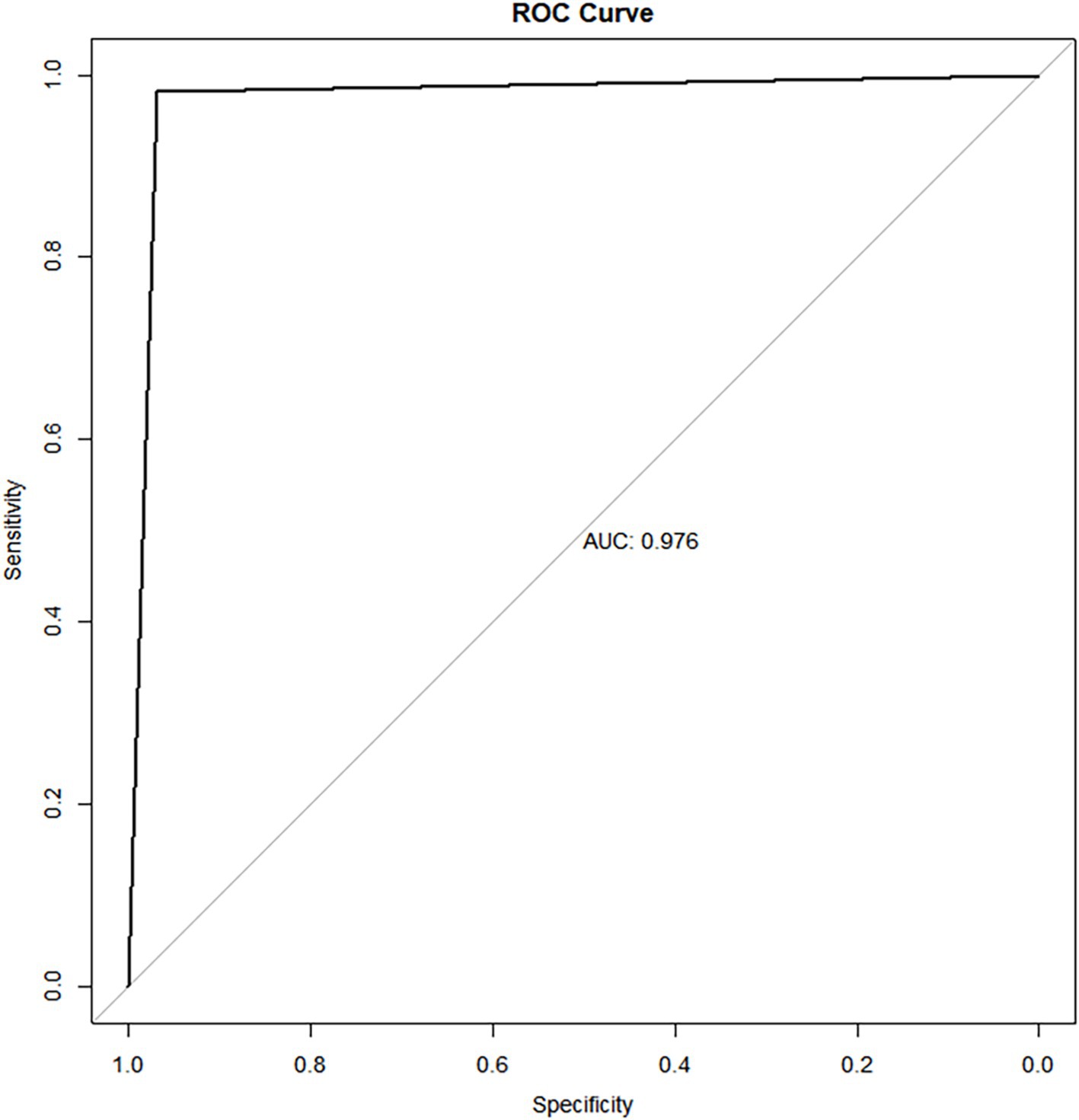
Figure 2. ROC curve of the random forest model for surgery decision prediction, the AUC was 0.976 (95%CI:0.962–0.990).
The comparison of the two models showed that the RF model outperformed the logistic regression model in both the training and testing datasets, with AUC values of 1.000 versus 0.985 for the training set and 0.997 versus 0.968 for the testing set (Figure 4).
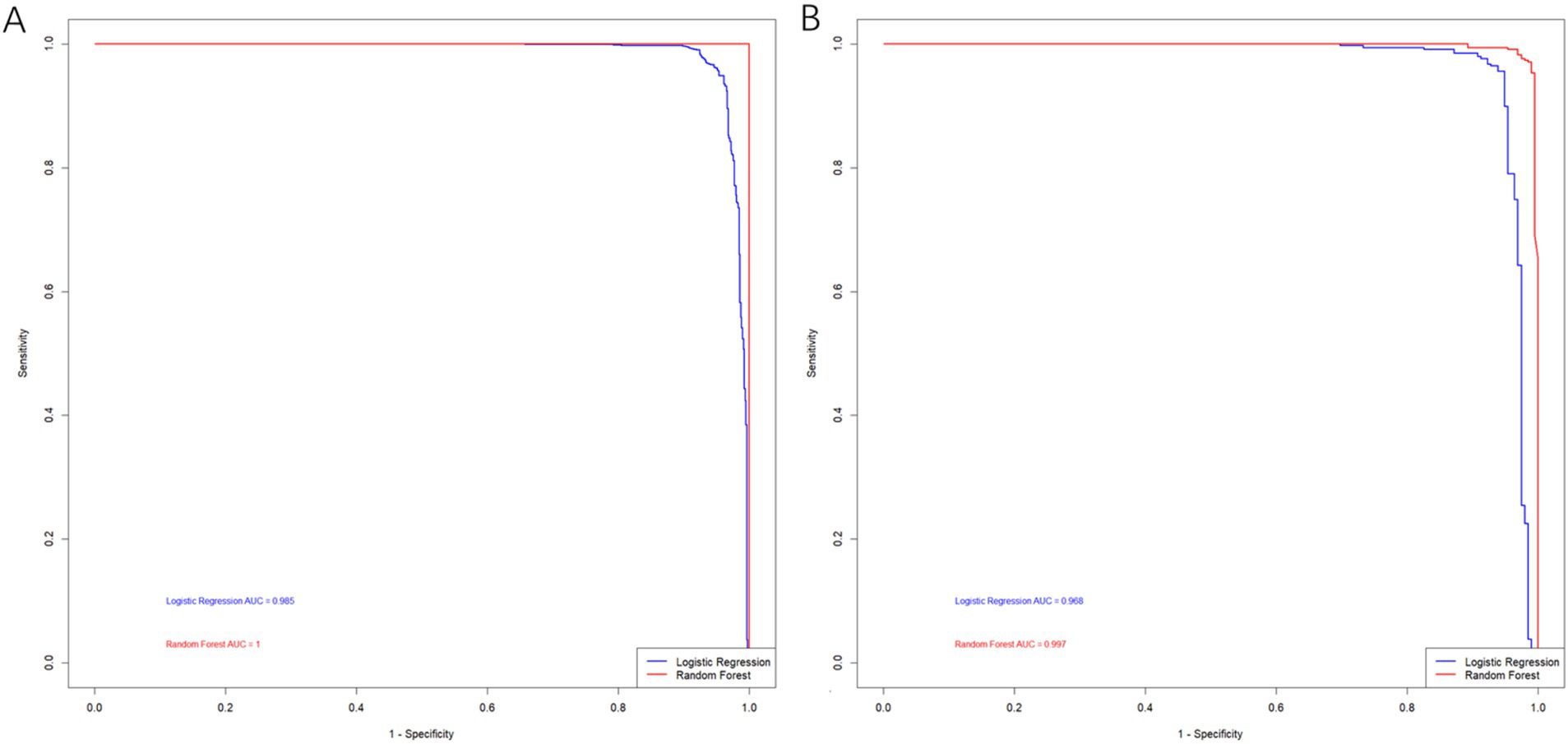
Figure 4. ROC curve of the random forest model and logistic regression model. (A) Training set; (B) Testing set.
Discussion
This study identified BSCVA, IOP, S, spherical equivalent, preoperative corneal thickness, BAD-D, CBI, TBI, dark pupil diameter, and Schirmer’s tear test as important factors for determining SMILE surgery suitability. Using these factors, a RF model was developed for predicting non-SMILE cases. The model achieved an AUC of 0.976, with an accuracy of 97.4% and an F1 score of 97.7%. These results suggest that machine learning methods could be a valuable tool for future surgical decision-making.
SMILE is an “all-in-one” surgical method for refractive correction that has been widely adopted worldwide. However, several risk factors have been associated with SMILE surgery and its prognosis. Lee et al. (18) found that steep corneal curvature is linked to a higher risk of significant postoperative residual astigmatism after SMILE surgery, Yang et al. (19) reported that steep corneal curvature, thin cap thickness, and high preoperative spherical equivalent are potential risk factors for the formation of an opaque bubble layer during SMILE surgery. Zhao et al. (20) demonstrated that the spherical equivalent is correlated with surgical complications. Consistent with these studies, our results indicated that the spherical equivalent differed significantly between patients suitable for SMILE and those not suitable, even after data splitting, with a p value < 0.001. Furthermore, the spherical equivalent was identified as a risk factor for SMILE surgery, with an OR of 1.27 (95% CI: 1.22–1.31, p < 0.001).
CBI, TBI, and BAD-D are biomechanical features widely used for evaluating myopia, SMILE surgery, and other ocular diseases. Zarei-Ghanavati et al. (21) conducted a study where participants received a 110-μm cap thickness in one eye and a 145-μm cap thickness in the fellow eye. Three months post-surgery, researchers found a significant difference in the CBI (21). Vinviguerra et al. (22) suggested that CBI-related techniques could be useful for managing patients who underwent keratectomy. Corral et al. explored the changes in CBI and TBI in patients who successfully underwent orthokeratology (23). Additionally, Zhang et al. (24) used BAD-D, CBI, and TBI in combination as early predictive indicators for myopia patients with keratoconus before refractive surgery, showing that TBI, CBI, and BAD-D had excellent diagnostic efficiency. In our study, aside from the spherical equivalent, CBI, TBI, and BAD-D were consistently significant (p < 0.001) in both the training and test cohorts. The univariate analysis for these three factors also indicated their potential as useful features for SMILE surgery decision-making.
RF is a well-established machine learning algorithm with extensive applications across medical science. From the perspectives of myopia and SMILE surgery, several studies have demonstrated its efficacy. Xu et al. (25) employed the RF model to explore changes in pupil diameter among myopic preschoolers. Wang et al. (26) developed various machine learning models and found that the RF model performed best in estimating lenticule thickness in SMILE surgery. Additionally, Li et al. (27) created an RF-based model for selecting refractive surgery based on clinical data, which showed a strong agreement with ophthalmologists, with a performance metric of 0.8775. Given that RF is a validated and robust model across diverse datasets, the current study did not compare RF with other models and we will incorporate other machine learning models in future analysis. Nonetheless, the RF model demonstrated excellent performance in terms of both AUC and accuracy in this study. The development of this prediction model had great clinical potential, for patients who consider the SMILE operation, the model could provide a personalized prediction, although the prognostic of SMILE was not included in the present study, the model correlation well with the opinion of experienced ophthalmologists, which was of ultimate importance for medical centers with limited medical resources.
Except for the features selected, there were many other reasons that could affect the execution of SMILE surgery, including patients’ willingness, financial status, and occupation requirement; all these factors were not included for the analysis; therefore, more detailed inclusion and exclusion criteria should be made for future studies. Moreover, to exclude potential confounding factors, mediation analysis should also be considered in future analyses. Consejo et al. (28) found that age is significantly correlated with both corneal tilt and corneal densitometry, and the interaction between corneal tilt and corneal densitometry is strongly influenced by age, in the present study, many parameters were included, and the mediation analysis could help filter features with greater importance.
However, this study has several limitations. Firstly, despite including patients from multiple medical centers, the retrospective nature of the study introduces selection bias, also, to improve the model performance, we did not select some data or further include data from other medical centers as an independent external validation set, which could limit the generalization ability of the present study. Secondly, the determination of suitability for SMILE surgery was made by experienced ophthalmologists, making the results heavily reliant on their clinical judgment and expertise. Thirdly, due to time constraints, we were unable to perform a prognosis-related analysis. Investigating the risk factors associated with SMILE surgery outcomes would be highly valuable for future research.
Conclusion
This study showed that factors such as BSCVA, IOP, S, spherical equivalent, preoperative corneal thickness, BAD-D, CBI, TBI, dark pupil diameter, and the Schirmer’s tear test are crucial in determining suitability for SMILE surgery. Additionally, the RF model was found to be an effective tool for aiding surgical decision-making. However, the retrospective design of this study limits its clinical applicability, highlighting the need for a larger prospective study to validate these findings.
Data availability statement
The original contributions presented in the study are included in the article/supplementary material, further inquiries can be directed to the corresponding authors.
Ethics statement
All procedures were performed in accordance with the ethical standards laid down in the 1964 Declaration of Helsinki and its later amendments. It was approved by the Ethics Committee of Xiangyang Central Hospital. The requirement for individual Informed consent was waived by Ethics Committee of Xiangyang Central Hospital because of the retrospective nature of the study. The study was carried out in accordance with the applicable guidelines and regulations.
Author contributions
SZ: Conceptualization, Investigation, Methodology, Writing – original draft, Writing – review & editing. YuY: Funding acquisition, Methodology, Software, Writing – original draft, Writing – review & editing. ZS: Investigation, Resources, Software, Writing – original draft, Writing – review & editing. LL: Methodology, Resources, Validation, Writing – original draft, Writing – review & editing. PW: Investigation, Software, Validation, Writing – original draft, Writing – review & editing. JZ: Formal analysis, Methodology, Software, Writing – original draft, Writing – review & editing. YaY: Conceptualization, Methodology, Project administration, Writing – original draft, Writing – review & editing.
Funding
The author(s) declare that no financial support was received for the research and/or publication of this article.
Conflict of interest
The authors declare that the research was conducted in the absence of any commercial or financial relationships that could be construed as a potential conflict of interest.
Generative AI statement
The authors declare that no Gen AI was used in the creation of this manuscript.
Publisher’s note
All claims expressed in this article are solely those of the authors and do not necessarily represent those of their affiliated organizations, or those of the publisher, the editors and the reviewers. Any product that may be evaluated in this article, or claim that may be made by its manufacturer, is not guaranteed or endorsed by the publisher.
References
1. Jackson, D, and Moosajee, M. The genetic determinants of axial length: from Microphthalmia to high myopia in childhood. Annu Rev Genomics Hum Genet. (2023) 24:177–202. doi: 10.1146/annurev-genom-102722-090617
2. Bullimore, MA, Ritchey, ER, Shah, S, Leveziel, N, Bourne, RRA, and Flitcroft, DI. The risks and benefits of myopia control. Ophthalmology. (2021) 128:1561–79. doi: 10.1016/j.ophtha.2021.04.032
3. Holden, BA, Fricke, TR, Wilson, DA, Jong, M, Naidoo, KS, Sankaridurg, P, et al. Global prevalence of myopia and high myopia and temporal trends from 2000 through 2050. Ophthalmology. (2016) 123:1036–42. doi: 10.1016/j.ophtha.2016.01.006
4. Vitale, S, Sperduto, RD, and Ferris, FL 3rd. Increased prevalence of myopia in the United States between 1971-1972 and 1999-2004. Arch Ophthalmol. (2009) 127:1632–9. doi: 10.1001/archophthalmol.2009.303
5. Chiang, SY, Weng, TH, Lin, CM, and Lin, SM. Ethnic disparity in prevalence and associated risk factors of myopia in adolescents. J Formos Med Assoc. (2020) 119:134–43. doi: 10.1016/j.jfma.2019.03.004
6. Wong, YL, and Saw, SM. Epidemiology of pathologic myopia in Asia and worldwide. Asia Pac J Ophthalmol. (2016) 5:394–402. doi: 10.1097/APO.0000000000000234
7. Singh, H, Singh, H, Latief, U, Tung, GK, Shahtaghi, NR, Sahajpal, NS, et al. Myopia, its prevalence, current therapeutic strategy and recent developments: a review. Indian J Ophthalmol. (2022) 70:2788–99. doi: 10.4103/ijo.IJO_2415_21
8. Gwiazda, J. Treatment options for myopia. Optom Vis Sci. (2009) 86:624–8. doi: 10.1097/OPX.0b013e3181a6a225
9. Shah, R, Shah, S, and Sengupta, S. Results of small incision lenticule extraction: all-in-one femtosecond laser refractive surgery. J Cataract Refract Surg. (2011) 37:127–37. doi: 10.1016/j.jcrs.2010.07.033
10. Song, J, Cao, H, Chen, X, Zhao, X, Zhang, J, Wu, G, et al. Small incision Lenticule extraction (SMILE) versus laser assisted stromal in situ Keratomileusis (LASIK) for astigmatism corrections: a systematic review and meta-analysis. Am J Ophthalmol. (2023) 247:181–99. doi: 10.1016/j.ajo.2022.11.013
11. Blum, M, Täubig, K, Gruhn, C, Sekundo, W, and Kunert, KS. Five-year results of small incision lenticule extraction (ReLEx SMILE). Br J Ophthalmol. (2016) 100:1192–5. doi: 10.1136/bjophthalmol-2015-306822
12. Moshirfar, M, Tukan, AN, Bundogji, N, Liu, HY, McCabe, SE, Ronquillo, YC, et al. Ectasia after corneal refractive surgery: a systematic review. Ophthalmol Ther. (2021) 10:753–76. doi: 10.1007/s40123-021-00383-w
13. AlKharashi, M, Bower, KS, Stark, WJ, and Daoud, YJ. Refractive surgery in systemic and autoimmune disease. Middle East Afr J Ophthalmol. (2014) 21:18–24. doi: 10.4103/0974-9233.124082
14. Anton, N, Doroftei, B, Ilie, OD, Ciuntu, RE, Bogdănici, CM, and Nechita-Dumitriu, I. A narrative review of the complex relationship between pregnancy and eye changes. Diagnostics (Basel). (2021) 11:1329. doi: 10.3390/diagnostics11081329
15. Fioretto, BS, Rosa, I, Andreucci, E, Mencucci, R, Marini, M, Romano, E, et al. Pharmacological stimulation of soluble guanylate cyclase counteracts the Profibrotic activation of human conjunctival fibroblasts. Cells. (2024) 13:360. doi: 10.3390/cells13040360
16. Ruiz-Lozano, RE, Hernández-Camarena, JC, Garza-Garza, LA, Bustamante-Arias, A, Colorado-Zavala, MF, and Cardenas-de la Garza, JA. Isotretinoin and the eye: a review for the dermatologist. Dermatol Ther. (2020) 33:e14029. doi: 10.1111/dth.14029
17. Choi, W, Bae, HW, Shin, HJ, Kim, EW, Kim, CY, Kim, M, et al. Predicting the safety zone for steroid-induced ocular hypertension induced by intravitreal dexamethasone implantation. Br J Ophthalmol. (2022) 106:1150–6. doi: 10.1136/bjophthalmol-2020-318401
18. Lee, CY, Shen, JH, Chao, CC, Lian, IB, Huang, JY, Yang, SF, et al. Topographic and surgical risk factors for high postoperative residual astigmatism after small incision lenticule extraction in patients with different degrees of myopia: a retrospective cohort study. BMC Ophthalmol. (2024) 24:45. doi: 10.1186/s12886-024-03296-x
19. Yang, S, Wang, H, Chen, Z, Li, Y, Chen, Y, and Long, Q. Possible risk factors of opaque bubble layer and its effect on high-order aberrations after small incision lenticule extraction. Front Med (Lausanne). (2023) 10:1156677. doi: 10.3389/fmed.2023.1156677
20. Zhao, J, Li, Y, Yu, T, Wang, W, Emmanuel, MT, Gong, Q, et al. Anterior segment inflammation and its association with dry eye parameters following myopic SMILE and FS-LASIK. Ann Med. (2023) 55:689–95. doi: 10.1080/07853890.2023.2181388
21. Zarei-Ghanavati, S, Jafarzadeh, SV, Es'haghi, A, Kiarudi, MY, Hassanzadeh, S, and Ziaei, M. Comparison of 110- and 145-μm small-incision Lenticule extraction cap thickness: a randomized contralateral eye study. Cornea. (2024) 43:154–8. doi: 10.1097/ICO.0000000000003294
22. Vinciguerra, R, Cancian, G, Ambrósio, R Jr, Elsheikh, A, Eliasy, A, Lopes, B, et al. Assessment of the specificity of corvis biomechanical index-laser vision correction (CBI-LVC) in stable corneas after phototherapeutic keratectomy. Int Ophthalmol. (2023) 43:4289–95. doi: 10.1007/s10792-023-02840-w
23. Pérez-Corral, J, Cardona, G, Piñero, DP, Barroso, D, and Armadans, L. Short- and mid-term changes in CORVIS ST parameters in successful, adult orthokeratology patients. Clin Exp Optom. (2023) 106:726–33. doi: 10.1080/08164622.2022.2140031
24. Zhang, M, Zhang, F, Li, Y, Song, Y, and Wang, Z. Early diagnosis of Keratoconus in Chinese myopic eyes by combining Corvis ST with Pentacam. Curr Eye Res. (2020) 45:118–23. doi: 10.1080/02713683.2019.1658787
25. Xu, S, Li, L, Han, W, Zhu, Y, Hu, Y, Li, Z, et al. Association between myopia and pupil diameter in preschoolers: evidence from a machine learning approach based on a real-world large-scale dataset. Ophthalmol Ther. (2024) 13:2009–22. doi: 10.1007/s40123-024-00972-5
26. Wang, H, Zheng, S, Tang, S, Zhang, X, Chen, Y, and Zhu, Y. Investigation of accuracy and influence factors of predicting lenticule thickness in small incision lenticule extraction by machine learning models. J Pers Med. (2023) 13:256. doi: 10.3390/jpm13020256
27. Li, J, Dai, Y, Mu, Z, Wang, Z, Meng, J, Meng, T, et al. Choice of refractive surgery types for myopia assisted by machine learning based on doctors' surgical selection data. BMC Med Inform Decis Mak. (2024) 24:41. doi: 10.1186/s12911-024-02451-0
Keywords: myopia, small-incision lenticule extraction, risk prediction, random forest, retrospective study
Citation: Zhang S, Yan Y, Shen Z, Liu L, Wang P, Zhu J and Yang Y (2025) Development of risk prediction model for small incision lenticule extraction. Front. Med. 12:1518889. doi: 10.3389/fmed.2025.1518889
Edited by:
Jos J. Rozema, University of Antwerp, BelgiumReviewed by:
Pan Long, General Hospital of Western Theater Command, ChinaMohammed Alharthi, Taif University, Saudi Arabia
Copyright © 2025 Zhang, Yan, Shen, Liu, Wang, Zhu and Yang. This is an open-access article distributed under the terms of the Creative Commons Attribution License (CC BY). The use, distribution or reproduction in other forums is permitted, provided the original author(s) and the copyright owner(s) are credited and that the original publication in this journal is cited, in accordance with accepted academic practice. No use, distribution or reproduction is permitted which does not comply with these terms.
*Correspondence: Yanning Yang, ZnkzNTU0QGhidWFzLmVkdS5jbg==; Jian Zhu, emh1amlhbjA4MjdAc2luYS5jb20=
†These authors share first authorship
 Shaowei Zhang1†
Shaowei Zhang1† Lei Liu
Lei Liu Jian Zhu
Jian Zhu Yanning Yang
Yanning Yang